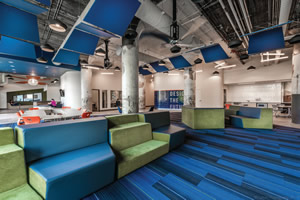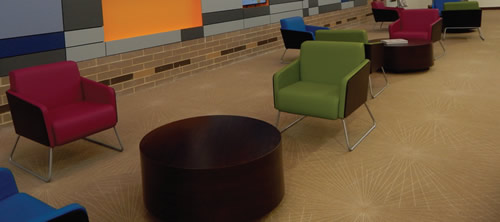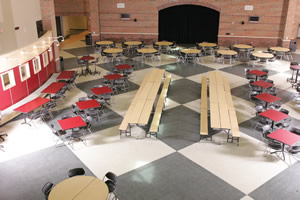Focus on Flooring

PHOTO © ANF ARCHITECTS
How well a school educates is at the core of its brand, how that school should be thought of and perceived. Other factors also impact that brand, including school buildings themselves, and particularly how buildings, their systems and technologies help educators teach and students achieve. Interior spaces are part of the equation as well.
Floors, as a fundamental finish of an interior, are a direct point of contact that can impact a school’s reputation by sending messages about how a school does things, for instance, as soon as students, staff, educators, and visitors enter the building.
Exemplars abound of attractive flooring systems and their evident maintenance that send good signals about a school. They include new terrazzo floors at Medicine Crow Middle School in Montana, in colors and looks that subtly suggest natural stream beds; carpet tile with a contemporary look and sound absorption qualities at Ballou High School in Washington, D.C.; vinyl composition tile with a pristine glossy finish at Triton Regional High School in New Jersey; cove base terrazzo and spotless vestibule carpet at Rapid City High School in South Dakota. The list goes on.
A district or school may be seeking to denote and connote what its programs and results prove: that it is an efficient, pragmatic, contemporary, and up-to-date institution, for example, or that it keeps pace with or leads change. Today, that notion of change may mean flexible teaching and learning across flexible spaces.
A floor supplier offers related insights: “We understand that today’s educational settings require more flexibility as spaces are often asked to allow for different uses during any given day,” explains Kevin Reusch, architectural/engineering sales manager at Stonhard. “These multi-use spaces require floors that handle a variety of conditions.” There’s more to it: At the same time, Reusch is noting “that administrators and designers often inquire about solutions that will provide a contemporary look.” He points out that the company has a range of durable responses, including products that are poured-in-place, providing seamless flooring that is easy to clean; provide “excellent acoustical performance;” lend themselves to be “water jet cut into custom shapes and logos.”

PHOTO © SCOTT BERMAN
In one instance, Cedar Springs Middle School in Michigan, Stonhard provided an aesthetically dynamic, urethane-based flooring system for the cafeteria, replacing a linoleum floor—with the company noting that the new floor was installed in 48 hours. The new system features an enormous checkerboard pattern punctuated with a functional yellow path leading to and from the dining area. The company provided floors in other school spaces, with key qualities reflective of the Cedar Springs way, so to speak. Those qualities, the company notes, include things like sound absorption, durability, easy maintenance, and “bright, bold colors…to help fuel an environment that is educational and imaginative.”
It can be a complex process to find a flooring solution that exemplifies what an institution is about while meeting everyday needs. Asking the right questions helps, and a key question is “what are we trying to achieve for students?” says Tarkett’s Jonathan Stanley, vice president, education. Answering that question should be part of the conversation “before the budget is set” for a new flooring system, he argues. Initial cost is inevitably part of that conversation, but he stresses that it should not just stop there. In Stanley’s view, that conversation should also be about performance, acoustics, longevity, ease, and affordability of maintenance, and providing a healthy environment in which to learn—as in products that fight asthma and allergies.
Another complexity is that “schools are seeking materials as permanent as possible”—with 30 to 50 years not an unusual expectation—while the only constant is the change that spaces and their uses undergo, Stanley says, explaining that diverse, resilient materials and systems can help “follow the design of changing spaces” and connect spaces more easily in the future.
On another tack related to the brand of a school, students want ownership of space. Stanley explains that things like logos and art, potentially created by students, expresses that feeling of ownership as well as “pride of place.” He adds that flooring is a “medium” best taken advantage of by systems that enable school logos to be created without replacing the entire floor. Tarkett’s Tandus Centiva company points out related options including luxury vinyl tile systems.
Visual identity, or customizing floors to match a school’s colors, are a way to express an institution’s brand, and there’s more. As J+J Flooring Group’s Bob Bethel, director of business development, Education, says, “A school’s brand extends beyond visual identity.”
To start with, “a flooring product must function to expectations. If a product becomes stained, scratched, scuffed or simply wears prematurely, that can negatively affect a school’s brand,” Bethel points out. Key factors impacting brand that need to be considered include sound reduction, comfort as well as “aesthetics, performance, maintenance, health, safety, and price,” says Bethel. “Often times, for various reasons, one aspect is selected over the other. When this happens, something is sacrificed, typically to the detriment of the brand.” The key: planning and research into all the options. The goal for districts and schools: To “get a flooring that positively extends their brand and creates a better experience for all that come in contact with it,” Bethel adds.

PHOTO © STONHARD
Various brand ideas were rolled out in flooring systems by J+J Flooring Group for Crosstown High School (CHX) in Memphis. Opening this year, the charter school was created out of a portion of a 91-year-old retail and distribution building in a redesign by ANF Architects. CHX focuses on personalized, project-based learning, according to J+J Flooring.
School officials and designers want the school’s “bold educational focus to come through in its design and visual identity,” the flooring supplier indicates. Accordingly, they selected Umbra Stripe, a J+J Flooring textile composite system that foregoes “traditional high school colors such as royal purples and hunter greens,” in favor of a palette with “modern, vibrant and energetic saturated colors ranging from bright yellow, rich orange to lime green.” Among the high school floors’ other qualities: durability, noise reduction, and versatility, with the same product “specified in multiple areas: classrooms, lounge spaces, the office area, and even in a café space.”
The result, according to J+J Flooring: “an energetic and cutting-edge school— from the dynamic curriculum all the way down to the innovative flooring.”
A lot goes into perceptions about a school—and the list includes flooring, which can be a highly conspicuous indication of a school’s brand. As Bethel adds, “typically one of the largest finishes of any interior space, a floor offers an exceptional way for a school to extend and exemplify its brand. But the flooring system for this ‘canvas’ must be chosen carefully.”
This article originally appeared in the School Planning & Management February 2018 issue of Spaces4Learning.